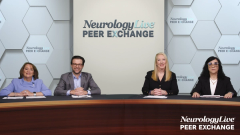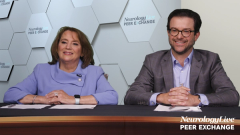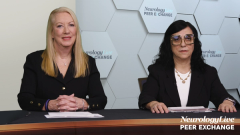
Comparison of AFFIRM (Reference Natalizumab) and Antelope (Biosimilar Natalizumab) Trials
Aliza Ben-Zacharia, PhD, DNP, ANP-BC and Amy Perrin Ross, APN discuss differences between biologic and biologic natalizumab phase 3 trials.
Episodes in this series

Amy Perrin Ross, APN, MSN, CNRN, MSCN: We know that the AFFIRM trial was the natalizumab [Tysabri] trial and the Antelope trial [NCT04115488] is the natalizumab biosimilar. So, Aliza, I’ll ask you to discuss if there are any differences between the biosimilar natalizumab studies and the actual AFFIRM or natalizumab studies. If so, do you have any concerns in terms of interpreting the data, for example, differences in terms of when the primary end point was measured, the timing, the frequency, [or] any of those kinds of things?
Aliza Ben-Zacharia, PhD, DNP, RN, ANP-BC, FAAN: I think, Amy, it’s really something that’s important for us as clinicians to think about because we always look at design. When we have journal club, we get fancy and think about the statistical analysis, and think about really the goal of each study. So, if you recall AFFIRM, I think [we were] in a mess at that time, correct? In the early 2000. The AFFIRM was done, and the goal was to think about and approve natalizumab and compare it to placebo and look at efficacy and safety of the medication. Of course, we have some safety concern, as we all know of PML [progressive multifocal leukoencephalopathy] back then. I think the goal of the AFFIRM [study] was it was a phase 3 RCT, randomized controlled trial, with 942 patients aged 18 to 50. The Antelope [trial] was same, phase 3. John mentioned already it was a parallel group randomized active control study. So, there was no placebo group, of course. It’s a comparable study. The Antelope [study] had the 531 patients aged 18 to 60, as Pat and John mentioned very nicely.
It was interesting when you looked at the design that the eligibility criteria between the AFFIRM and the Antelope. They both had at least 1 documented relapse in the prior year, which we see very often. They both had the same EDSS [Kurtzke Expanded Disability Status Scale], zero to 5, as John you just mentioned. What was really interesting for me that the AFFIRM [trial] said when they looked at MRI eligibility criteria, they mentioned MRI lesion consistent with MS [multiple sclerosis]. I think it belongs to that era of MS studies. Interestingly, the Antelope [study] was more specific, as John mentioned. It’s equal to 1 gadolinium-enhancing lesion, active lesions, or more or equal than 9 T2 lesions. So, you can see, I think, the different era that the actual biosimilar comparable study to the biologic was more specific.
When we think about the end point, as Amy asked and questioned about it, [with] the AFFIRM [trial], the end point were 2 and definitely different treatment time. It was 1 year rate of clinical relapse, and that was a primary end point looking at number and the rates of relapses. The second primary end point, which I think is very important to clinicians, is disability accumulation. That was a 2-year end point as compared to the Antelope [trial], which was 24 weeks. The primary end point was cumulative new active lesions, and that was the primary. In the study was biosimilar to biologic, 1 to 1, and the natalizumab was 2 to 1.
I wanted to mention that I have some concerns because the biologic natalizumab study [being a] longer period of time, and we think about a 2-year study, and the biosimilar was a shorter time, 24 weeks. Again, the aim is different. You want to really show clinical equivalence. It’ll be something that I will have to think about [with] each patient individually and think comfortably once we have the data and it’s all out there. I think that I would’ve loved to see [a] longer clinical equivalence study because sometimes the AEs [adverse events] do not come early enough as you know. When you do [a] longer study, you can see more adverse events, especially if they’re rare. So, to say honestly, I have some concern about that. Hopefully, perhaps, we’ll have more comparable studies in the future. I don’t know what you guys think.
Patricia Melville, RN, NP-C, CCRC, MSCN: Well, I think it’s very interesting that what you comment about that they were both in different eras. When you think about the AFFIRM trial and the Antelope trial, it was almost 15 or almost even 20 years difference between those 2 trials, right? The AFFIRM trial was done in the early 2000s. And, of course, the Antelope trial [was] just done. I’m going to say around 2020 or so. So a good 15 to 20 years difference. It shows how our knowledge of MS has changed, our expectations, [and how] our outcome measures in trials have changed as well.
Amy Perrin Ross, APN, MSN, CNRN, MSCN: I think our patients have changed, Pat. We’re choosing patients much differently than we used to. Back in the early days of MS therapies, I still remember hearing colleagues say, “Oh, we don’t need to start you on that MS medicine because you don’t need it yet.” Well, clearly, our thoughts have changed dramatically since then. I think you’ve brought up some really good points about patient selection, Aliza. One of my thoughts in terms of thinking about the timing and the evidence that’s available, well, there’s nothing like real-world evidence, which we will get obviously once the biosimilars are approved. We’ve continued to see more of them, [which] we will definitely get more real-world evidence. You know, I think it’s incumbent upon us as clinicians to be quite vigilant [when] thinking about things that might pique our interest or that we might be questioning, and to report those things. Things that we might just say, “Oh, you know, we’ll just let it go.” Because of the shorter duration of the biosimilars, I think we as clinicians should be a bit more vigilant in terms of identifying things that may or may not become an issue and reporting those things early on. That’s the way we’re going to get true objective real-world evidence based on this.
Another thing I think about, and then I’ll ask John for some of your thoughts about this, is that something again I can assure my patients of, yeah, it was a short duration study, but these people went back and forth and back and forth. And so, if we didn’t see a major change, for example, in tolerability or safety issues going from a reference product to a biosimilar back to a reference, I would not expect to see that when my patients go from a reference product to a biosimilar. I think especially that first infusion in terms of natalizumab is going to be a big leap of faith not only for the prescribers, but definitely for the patients. Whatever I can do to help make them a bit more comfortable with that decision. The idea of just back and forth and back and forth has made me more comfortable. I think that’s something I will spend some time talking to my patients about. Thoughts from you on that, John?
John Kramer, PA-C: I agree. I think that the use of rituximab as a biosimilar at our institution has been something that we’ve been accustomed to now for quite some time. I think that was our first exposure to the use of a biosimilar in the world of neuro autoimmune disease. So, my hope is that, as we’ve discussed before, that in other autoimmune conditions, [and] other biologic products, there is this framework in place that ideally will allow us to feel a lot more comfortable right out of the gate with these newer biosimilars for MS patients.
Transcript Edited for Clarity
Newsletter
Keep your finger on the pulse of neurology—subscribe to NeurologyLive for expert interviews, new data, and breakthrough treatment updates.






